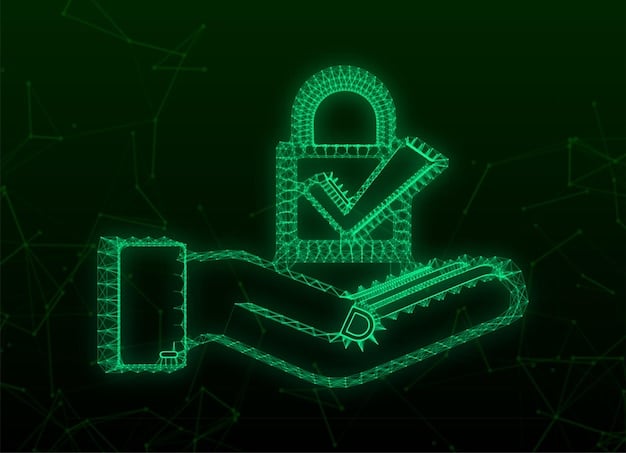File Integrity Monitoring: Secure US Systems from Unauthorized Changes

File Integrity Monitoring (FIM) ensures the security and compliance of US systems by detecting and alerting on unauthorized changes to critical system files and applications, safeguarding against data breaches and operational disruptions.
In the ever-evolving landscape of cybersecurity threats, maintaining the integrity of your critical system files and applications is paramount. This is where File Integrity Monitoring: Detecting Unauthorized Changes to Critical System Files and Applications in US becomes an essential component of your security strategy.
Understanding File Integrity Monitoring (FIM) in the US Context
File Integrity Monitoring (FIM) is a critical security practice that focuses on detecting unauthorized changes to important system files and applications. In the US, where regulatory compliance is stringent and cyber threats are rampant, FIM serves as a cornerstone of cybersecurity.
By continuously monitoring files and alerting administrators to any unexpected modifications, FIM helps organizations maintain the security, compliance, and operational stability of their systems. It ensures that alterations made to critical files are authorized and legitimate, preventing malicious actors from compromising sensitive data or disrupting essential services.
What Constitutes a Critical System File?
Critical system files encompass a wide range of elements vital to an organization’s operations. These include:
- Configuration files: These files dictate how systems and applications operate, making them prime targets for attackers looking to manipulate settings and gain unauthorized access.
- Operating system files: Essential for system functionality, any alteration to these files could cause instability or vulnerabilities.
- Application executables: The core programs that drive business processes, unauthorized changes to them can have severe consequences.
- DLLs (Dynamic Link Libraries): Shared libraries used by multiple programs, tampering with them can affect numerous applications.
Evolving Threat Landscape in the US
The US faces a constant barrage of cyber threats, from ransomware attacks to insider threats. FIM is an essential part of addressing these challenges:
- Ransomware Protection: Detecting unauthorized file encryption attempts can help prevent ransomware attacks from taking hold.
- Insider Threat Detection: Monitoring changes made by employees can detect malicious or negligent behavior.
- Compliance Assurance: FIM helps organizations meet regulatory requirements by providing evidence of file integrity.
File Integrity Monitoring is not merely a tool; it’s a strategic defense that keeps your systems secure and compliant in the face of ever-evolving threats in the US.

How File Integrity Monitoring Works: A Technical Overview
At its core, File Integrity Monitoring operates by creating a baseline of known-good files. This baseline includes cryptographic hashes, file sizes, modification dates, and other relevant attributes. The FIM system then continuously monitors these files, comparing them against the baseline.
When changes occur, the FIM system generates alerts, providing administrators with detailed information about the modification. This enables them to investigate and determine whether the change was authorized or if it represents a potential security threat.
Key Techniques Used in FIM
Several techniques are commonly employed in File Integrity Monitoring:
- Hashing Algorithms: Cryptographic algorithms like SHA-256 and MD5 generate unique fingerprints of files, allowing for precise change detection.
- Real-time Monitoring: Continuous monitoring ensures that changes are detected as they occur, minimizing the window of opportunity for attackers.
- Change Auditing: Detailed logs of file modifications provide a comprehensive audit trail for security investigations and compliance reporting.
Baseline Establishment
Establishing an accurate and reliable baseline is crucial for effective FIM. This involves:
- Scanning all critical files
- Establishing a secure baseline
- Regular Baseline Updates
By understanding the technical underpinnings of FIM, organizations can leverage its capabilities to safeguard their systems from unauthorized changes and maintain a strong security posture.
Benefits of Implementing File Integrity Monitoring in the US
Implementing File Integrity Monitoring provides a variety of benefits, ranging from improved security posture to enhanced compliance efforts. For organizations operating in the US, where regulatory requirements are stringent and cyber threats are increasingly sophisticated, these advantages are especially valuable.
FIM helps organizations proactively detect and respond to unauthorized changes, reducing the risk of data breaches, system compromises, and operational disruptions. By providing real-time alerts and detailed audit trails, FIM enables security teams to quickly identify and remediate potential threats, minimizing their impact.
Enhanced Security Posture
FIM significantly improves an organization’s security posture by:
- Detecting Malware: Identifying unauthorized file modifications caused by malware.
- Preventing Data Breaches: Monitoring sensitive files for signs of tampering.
- Reducing Attack Surface: Identifying and mitigating vulnerabilities in system configurations.
Compliance with Regulatory Requirements
Many US regulations mandate the implementation of file integrity monitoring, including:
- PCI DSS: The Payment Card Industry Data Security Standard requires FIM for systems processing cardholder data.
- HIPAA: The Health Insurance Portability and Accountability Act mandates FIM for protecting electronic protected health information (ePHI).
- NIST: The National Institute of Standards and Technology recommends FIM as part of its cybersecurity framework.
Operational Efficiency
FIM can also improve operational efficiency by:
- Automating Change Management: Streamlining the process of tracking and approving file modifications.
- Reducing Downtime: Quickly identifying and resolving unauthorized changes that could cause system instability.
- Improving Incident Response: Providing detailed audit trails for security investigations.
The benefits of implementing File Integrity Monitoring are far-reaching, enhancing security, compliance, and operational efficiency for organizations in the US.
Implementing File Integrity Monitoring: Best Practices for US Organizations
Implementing File Integrity Monitoring effectively requires careful planning and adherence to best practices. Choosing the right tools, configuring them appropriately, and integrating FIM into existing security workflows are crucial steps for success.
For organizations operating in the US, it’s also essential to consider regulatory requirements and industry standards when implementing FIM. Ensuring that the FIM solution meets the specific needs of the organization and complies with relevant regulations is paramount.
Selecting the Right FIM Solution
When choosing a FIM solution, consider factors such as:
- Scalability: The ability to monitor a large number of files and systems.
- Real-time Monitoring: The ability to detect changes as they occur.
- Integration: Compatibility with existing security tools and workflows.
Configuring FIM Effectively
Effective configuration of FIM is critical for accurate and reliable monitoring:
- Prioritize Critical Files: Focus on monitoring the most important files and directories.
- Establish Baselines: Create a baseline of known-good files to detect unauthorized changes.
- Configure Alerts: Set up alerts for specific types of file modifications that warrant investigation.
Integrating FIM into Security Workflows
FIM should be integrated into existing security workflows to ensure timely and effective response to alerts:
- Incident Response: Use FIM alerts to trigger incident response procedures.
- Change Management: Integrate FIM with change management processes to track and approve file modifications.
- Security Information and Event Management (SIEM): Integrate FIM alerts into SIEM systems for centralized monitoring and analysis.

By following these best practices, US organizations can effectively implement File Integrity Monitoring and strengthen their security posture against unauthorized changes.
Advanced FIM Techniques and Technologies
As cyber threats continue to evolve, advanced File Integrity Monitoring techniques and technologies are emerging to provide even greater protection. These advanced approaches leverage machine learning, threat intelligence, and other cutting-edge capabilities to enhance change detection and incident response.
For organizations in the US seeking to stay ahead of the threat landscape, exploring and implementing these advanced FIM techniques can provide a significant advantage. By incorporating these innovative approaches, organizations can detect more sophisticated attacks, reduce false positives, and improve their overall security posture.
Machine Learning for Anomaly Detection
Machine learning algorithms can be used to identify anomalous file changes that deviate from normal patterns. This helps to:
- Detect Zero-Day Exploits: Identify previously unknown vulnerabilities and attacks.
- Reduce False Positives: Learn from historical data to filter out legitimate changes.
- Improve Threat Detection: Identify subtle changes that might be missed by traditional FIM techniques.
Threat Intelligence Integration
Integrating threat intelligence feeds into FIM systems can provide valuable context and insights into detected changes. This enables organizations to:
- Identify Known Threats: Match file changes against known malware signatures and IOCs.
- Prioritize Alerts: Focus on investigating changes that are associated with known threats.
- Improve Incident Response: Gain access to threat intelligence data to inform incident response procedures.
Behavioral Analysis
Behavioral analysis techniques can be used to monitor the behavior of processes that are modifying files. This helps to:
- Detect Malicious Activity: Identify processes that are exhibiting suspicious behavior, such as attempting to modify system files.
- Prevent Privilege Escalation: Monitor processes for attempts to escalate privileges and gain unauthorized access.
- Improve Threat Detection: Identify attacks that might be missed by traditional FIM techniques.
By adopting these advanced FIM techniques and technologies, US organizations can enhance their ability to detect and respond to sophisticated cyber threats, ensuring the security and integrity of their critical systems.
The Future of File Integrity Monitoring in the US
The future of File Integrity Monitoring in the US is likely to be shaped by several key trends, including the increasing sophistication of cyber threats, the growing adoption of cloud computing, and the evolving regulatory landscape. As organizations continue to face new and complex security challenges, FIM will play an increasingly important role in protecting their critical systems and data.
Looking ahead, FIM solutions are likely to become more intelligent, automated, and integrated with other security tools. They will leverage advanced technologies such as artificial intelligence, machine learning, and threat intelligence to provide even greater protection against unauthorized changes and cyber threats.
Cloud-Based FIM
Cloud computing is transforming the way organizations operate, and FIM is adapting to this new environment:
- Scalability: Cloud-based FIM solutions can easily scale to monitor large numbers of files and systems across multiple cloud environments.
- Automation: Cloud-based FIM solutions can automate many of the tasks associated with FIM, such as baseline establishment and change detection.
- Integration: Cloud-based FIM solutions can integrate with other cloud security tools to provide a comprehensive security posture.
AI-Powered FIM
Artificial intelligence is playing an increasingly important role in FIM:
- Anomaly Detection: AI algorithms can identify anomalous file changes that deviate from normal patterns.
- Threat Intelligence: AI-powered FIM solutions can integrate with threat intelligence feeds to provide valuable context and insights into detected changes.
- Automated Incident Response: AI can automate incident response procedures, reducing the time it takes to respond to security incidents.
Evolving Regulatory Landscape
The regulatory landscape is constantly evolving, and FIM is adapting to meet these new requirements:
- Increased Scrutiny: Regulators are placing increased scrutiny on organizations to ensure that they are adequately protecting their critical systems and data.
- Stricter Requirements: New regulations are imposing stricter requirements for FIM, such as requiring organizations to implement real-time monitoring and automated incident response.
- Greater Enforcement: Regulators are taking a more aggressive approach to enforcement, issuing fines and other penalties to organizations that fail to comply with regulations.
| Key Aspect | Brief Description |
|---|---|
| 🛡️ Core Function | Detects unauthorized changes to system files & applications in US. |
| 🚨 Key Benefit | Enhances security, ensures regulatory compliance (PCI DSS, HIPAA). |
| ⚙️ Implementation | Requires baseline setup, real-time monitoring & integration. |
| 🤖 Future Trends | Cloud FIM, AI-powered analysis & evolving regulatory needs. |
Frequently Asked Questions (FAQ)
▼
The primary goal is to detect unauthorized changes made to critical system files and applications in order to protect against data breaches and ensure system stability.
▼
FIM is important because regulations like PCI DSS and HIPAA require it to protect sensitive data. It provides audit trails for compliance verification and helps prevent data breaches.
▼
FIM works by creating a baseline of known-good files and continuously monitoring for deviations. When changes occur, alerts are generated for investigation and remediation.
▼
Best practices include selecting the right FIM solution, configuring it effectively, prioritizing critical files, and integrating it into existing security workflows for incident response.
▼
Future trends include cloud-based FIM, AI-powered analytics for advanced threat detection, and adaptation to evolving regulatory requirements for greater security and compliance.
Conclusion
In conclusion, File Integrity Monitoring (FIM) is a crucial component of a comprehensive cybersecurity strategy for US organizations. By detecting unauthorized changes to critical system files and applications, FIM helps organizations maintain the integrity of their systems, comply with regulatory requirements, and protect against cyber threats now and into the future.





